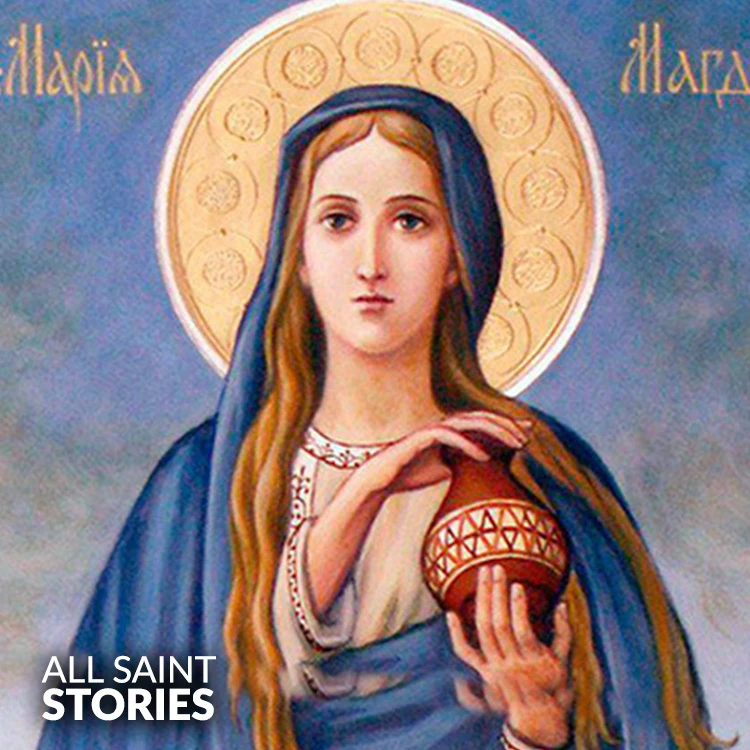"Saint Mary Magdalene, faithful follower of Christ, who witnessed His resurrection and shared His love, intercede for us with your devotion and courage. Help us to walk in the light of His truth, and to proclaim His mercy with the same heart of love. Guide us in our own journey of faith, and pray for us, that we may grow in holiness. Amen."
ST. MARY MAGDALENE
ST. MARY MAGDALENE

St. Mary Magdalene was a close follower of Jesus, known for her deep faith and transformation after being healed by Him. She was present at the crucifixion and was the first to witness and proclaim His resurrection, earning her the title "Apostle to the Apostles."
Mary Magdalene was a woman from the town of Magdala, located near the Sea of Galilee. Her name indicates her origin—Magdalene meaning "from Magdala." The Gospels tell us that she was healed by Jesus when He cast out seven demons from her, an act that marked a radical transformation in her life. After this experience, she became one of Jesus’ most devoted followers. Along with other women, she supported Jesus and His ministry, both materially and spiritually.
She plays a vital role in the events of the Passion and Resurrection. Mary Magdalene remained with Jesus during His crucifixion, standing by the cross with His mother Mary and the disciple John. Her presence during this painful moment reflects her unwavering devotion. After Jesus' death, she witnessed His burial, making her one of the key eyewitnesses to both His death and what followed after.
On the third day after Jesus' crucifixion, Mary Magdalene visited His tomb and found it empty. In the Gospel of John, she was the first person to encounter the risen Christ. At first, she did not recognize Him, mistaking Him for a gardener, but upon hearing Him say her name, she immediately knew it was Jesus. He told her to inform the apostles of His resurrection, a commission that gave her the title "Apostle to the Apostles" in Christian tradition.
Throughout Church history, Mary Magdalene's legacy has been subject to confusion. She was at times mistakenly conflated with other biblical figures, such as the unnamed sinful woman in Luke's Gospel or Mary of Bethany, sister of Martha and Lazarus. However, modern biblical scholarship and official Church teaching have clarified her distinct identity.
In medieval traditions, particularly in France, it was believed that Mary Magdalene traveled to Provence after the Resurrection. According to this legend, she lived a life of contemplation in a cave—La Sainte-Baume—and was later buried in the region. Her relics were venerated in the town of Saint-Maximin-la-Sainte-Baume.
In 2016, Pope Francis elevated her memorial on July 22 to a feast day, highlighting her essential role in the story of salvation. She is recognized as a symbol of divine mercy and the transformative power of Jesus’ love.
St. Mary Magdalene is venerated as the patron saint of penitent sinners, converts, contemplative life, and women. Her example continues to inspire countless Christians who find hope in her story of repentance, discipleship, and courage.
Video Not Found
The information on this website is compiled from various trusted sources. While we aim for accuracy, some details may be incomplete or contain discrepancies.
If you notice any errors or have additional information about this saint, please use the form on the left to share your suggestions. Your input helps us improve and maintain reliable content for everyone.
All submissions are reviewed carefully, and your personal details will remain confidential. Thank you for contributing to the accuracy and value of this resource.
Credits & Acknowledgments
- Anudina Visudhar (Malayalam) – Life of Saints for Everyday
by Msgr. Thomas Moothedan, M.A., D.D. - Saint Companions for Each Day
by A. J. M. Mausolfe & J. K. Mausolfe - US Catholic (Faith in Real Life) – Informational articles
- Wikipedia – General reference content and images
- Anastpaul.com – Saint images and reflections
- Pravachaka Sabdam (Malayalam) – Saint-related content and insights
We sincerely thank these authors and platforms for their valuable contributions. If we have unintentionally missed any attribution, please notify us, and we will make the correction promptly.
If you have any suggestion about ST. MARY MAGDALENE
Your suggestion will help improve the information about this saint. Your details will not be disclosed anywhere.
© 2025 Copyright @ www.allsaintstories.com





 English
English
 Italian
Italian
 French
French
 Spanish
Spanish
 Malayalam
Malayalam
 Russian
Russian
 Korean
Korean
 Sinhala
Sinhala
 Japanese
Japanese
 Arabic
Arabic
 Portuguese
Portuguese
 Bantu
Bantu
 Greek
Greek
 German
German
 Dutch
Dutch
 Filipino
Filipino